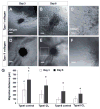Dental pulp stem cell-derived chondrogenic cells demonstrate differential cell motility in type I and type II collagen hydrogels
- PMID: 29452287
- PMCID: PMC5972055
- DOI: 10.1016/j.spinee.2018.02.007
Dental pulp stem cell-derived chondrogenic cells demonstrate differential cell motility in type I and type II collagen hydrogels
Abstract
Background context: Advances in the development of biomaterials and stem cell therapy provide a promising approach to regenerating degenerated discs. The normal nucleus pulposus (NP) cells exhibit similar phenotype to chondrocytes. Because dental pulp stem cells (DPSCs) can be differentiated into chondrogenic cells, the DPSCs and DPSCs-derived chondrogenic cells encapsulated in type I and type II collagen hydrogels can potentially be transplanted into degenerated NP to repair damaged tissue. The motility of transplanted cells is critical because the cells need to migrate away from the hydrogels containing the cells of high density and disperse through the NP tissue after implantation.
Purpose: The purpose of this study was to determine the motility of DPSC and DPSC-derived chondrogenic cells in type I and type II collagen hydrogels.
Study design/setting: The time lapse imaging that recorded cell migration was analyzed to quantify the cell migration velocity and distance.
Methods: The cell viability of DPSCs in native or poly(ethylene glycol) ether tetrasuccinimidyl glutarate (4S-StarPEG)-crosslinked type I and type II collagen hydrogels was determined using LIVE/DEAD cell viability assay and AlamarBlue assay. DPSCs were differentiated into chondrogenic cells. The migration of DPSCs and DPSC-derived chondrogenic cells in these hydrogels was recorded using a time lapse imaging system. This study was funded by the Regional Institute on Aging and Wichita Medical Research and Education Foundation, and the authors declare no competing interest.
Result: DPSCs showed high cell viability in non-crosslinked and crosslinked collagen hydrogels. DPSCs migrated in collagen hydrogels, and the cell migration speed was not significantly different in either type I collagen or type II collagen hydrogels. The migration speed of DPSC-derived chondrogenic cells was higher in type I collagen hydrogel than in type II collagen hydrogel. Crosslinking of type I collagen with 4S-StarPEG significantly reduced the cell migration speed of DPSC-derived chondrogenic cells.
Conclusions: After implantation of collagen hydrogels encapsulating DPSCs or DPSC-derived chondrogenic cells, the cells can potentially migrate from the hydrogels and migrate into the NP tissue. This study also explored the differential cell motility of DPSCs and DPSC-derived chondrogenic cells in these collagen hydrogels.
Keywords: Chondrogenic cell; Collagen; Dental pulp stem cells; Migration; Nucleus pulposus; Regeneration.
Copyright © 2018 Elsevier Inc. All rights reserved.
Figures







Similar articles
-
Effects of cell culture time and cytokines on migration of dental pulp stem cell-derived chondrogenic cells in collagen hydrogels.Physiol Rep. 2024 Sep;12(18):e70063. doi: 10.14814/phy2.70063. Physiol Rep. 2024. PMID: 39327065 Free PMC article.
-
Enhanced chondrogenic differentiation of dental pulp stem cells using nanopatterned PEG-GelMA-HA hydrogels.Tissue Eng Part A. 2014 Nov;20(21-22):2817-29. doi: 10.1089/ten.TEA.2013.0614. Epub 2014 Jun 30. Tissue Eng Part A. 2014. PMID: 24749806 Free PMC article.
-
Human dental pulp stem cells expressing transforming growth factor β3 transgene for cartilage-like tissue engineering.Cytotherapy. 2013 Jun;15(6):712-25. doi: 10.1016/j.jcyt.2013.01.012. Epub 2013 Mar 7. Cytotherapy. 2013. PMID: 23474328
-
Systematic Review of Human Dental Pulp Stem Cells for Cartilage Regeneration.Tissue Eng Part B Rev. 2020 Feb;26(1):1-12. doi: 10.1089/ten.TEB.2019.0140. Epub 2020 Jan 22. Tissue Eng Part B Rev. 2020. PMID: 31744404
-
Dental Pulp Stem Cells: Advances to Applications.Stem Cells Cloning. 2020 Feb 13;13:33-42. doi: 10.2147/SCCAA.S166759. eCollection 2020. Stem Cells Cloning. 2020. PMID: 32104005 Free PMC article. Review.
Cited by
-
Application of Biocompatible Scaffolds in Stem-Cell-Based Dental Tissue Engineering.Adv Exp Med Biol. 2023;1409:83-110. doi: 10.1007/5584_2022_734. Adv Exp Med Biol. 2023. PMID: 35999347 Review.
-
Synthetic Scaffold/Dental Pulp Stem Cell (DPSC) Tissue Engineering Constructs for Bone Defect Treatment: An Animal Studies Literature Review.Int J Mol Sci. 2020 Dec 21;21(24):9765. doi: 10.3390/ijms21249765. Int J Mol Sci. 2020. PMID: 33371390 Free PMC article. Review.
-
Effects of cell culture time and cytokines on migration of dental pulp stem cell-derived chondrogenic cells in collagen hydrogels.Physiol Rep. 2024 Sep;12(18):e70063. doi: 10.14814/phy2.70063. Physiol Rep. 2024. PMID: 39327065 Free PMC article.
-
Effects of p-Cresol on Senescence, Survival, Inflammation, and Odontoblast Differentiation in Canine Dental Pulp Stem Cells.Int J Mol Sci. 2020 Sep 21;21(18):6931. doi: 10.3390/ijms21186931. Int J Mol Sci. 2020. PMID: 32967298 Free PMC article.
-
Selenium-SelK-GPX4 axis protects nucleus pulposus cells against mechanical overloading-induced ferroptosis and attenuates senescence of intervertebral disc.Cell Mol Life Sci. 2024 Jan 22;81(1):49. doi: 10.1007/s00018-023-05067-1. Cell Mol Life Sci. 2024. PMID: 38252317 Free PMC article.
References
-
- Gan Y, Li P, Wang L, Mo X, Song L, Xu Y, Zhao C, Ouyang B, Tu B, Luo L, Zhu L, Dong S, Li F, Zhou Q. An interpenetrating network-strengthened and toughened hydrogel that supports cell-based nucleus pulposus regeneration. Biomaterials. 2017 Aug;136:12–28. doi: 10.1016/j.biomaterials.2017.05.017. - DOI - PubMed
Publication types
MeSH terms
Substances
Grants and funding
LinkOut - more resources
Full Text Sources
Other Literature Sources
Medical
Miscellaneous

